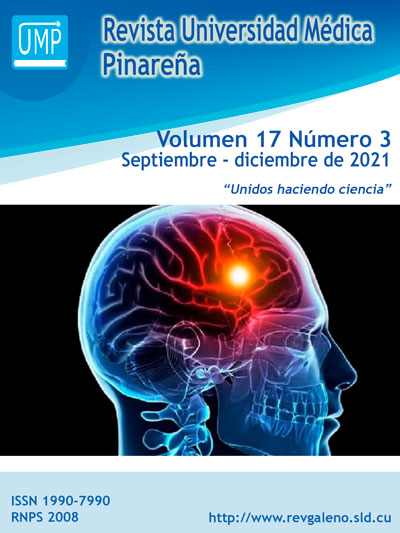Relationship between cytological and histological findings in patients from an Amazonian hospital in Peru
Keywords:
Cervix Uteri, Atypical Squamous Cells of the Cervix, Squamous Intraepithelial Lesions of the Cervix.Abstract
Introduction: cervical cancer remains one of the leading causes of cancer-related deaths worldwide.
Objectives: to describe the positive cytological and histopathological findings in patients with cervical cancer.
Method: an observational, descriptive, cross-sectional study was carried out. A non-probabilistic intentional sampling with 80 women whose history presented complete information, taken from the clinical records, to make the correlation between cytological and histopathological findings in the Amazonian hospital of Yarinacocha, Peru during the period 2013 to 2017. Descriptive and multivariate statistics were used.
Results: 34 % of the patients with positive cytology were between 40 and 49 years old. Fifteen percent of the cytological studies performed were positive. The ASCUS category was mostly related to Cervical Intraepithelial Neoplasia-1 (CIN-1) or mild dysplasia in 83 % of the cases; only 6 % were severe dysplasia or CIN-3. Low-grade Squamous Intraepithelial Lesions (SILs) were associated with CIN-2 moderate dysplasia in 60 %. High-grade SILs were associated with mild dysplasia CIN-1 in 58 % and 25 % were associated with severe dysplasia CIN-3. The cytological diagnosis of carcinoma was associated with mild dysplasia CIN-1 (66 %).
Conclusion: it is concluded that there is a correlation between cytological lesions and their relationship with histological lesions. As the ASCUS type lesions; while by histology, CIN-1 type lesions predominated. A significant association was found between the type of lesion by cytology and histology.
Downloads
References
2. Small W, Bacon MA, Bajaj A, Chuang LT, Fisher BJ, Harkenrider MM, et al. Cervical cancer: A global health crisis. Cancer [Internet]. 2017 [citado 31/05/2020]; 123(13):2404–12. Disponible en: https://acsjournals.onlinelibrary.wiley.com/doi/abs/10.1002/cncr.30667
3. Wright, Jr TC. 2001 Consensus Guidelines for the Management of Women With Cervical Cytological Abnormalities. JAMA [Internet]. 2002 [citado 31/05/2020]; 287(16):2120. Disponible en: http://jama.jamanetwork.com/article.aspx?doi=10.1001/jama.287.16.2120
4. Fallani MG, Penna C, Fambrini M, Marchionni M. Cervical cytologic reports of ASCUS and LSIL: Cyto-histological correlation and implication for management. Minerva Ginecol [Internet]. 2002 [citado 31/05/2020]; 54(3):263–9. Disponible en: https://europepmc.org/article/med/12063442
5. Liu Y, Alqatari M, Sultan K, Ye F, Gao D, Sigel K, et al. Using p16 immunohistochemistry to classify morphologic cervical intraepithelial neoplasia 2: correlation of ambiguous staining patterns with HPV subtypes and clinical outcome. Hum Pathol [Internet]. 2017 [citado 31/05/2020]; 66:144–51. Disponible en: https://www.sciencedirect.com/science/article/pii/S0046817717302368
6. Yang W, Lu YP, Yang YZ, Kang JR, Jin YD, Wang HW. Expressions of programmed death (PD)-1 and PD-1 ligand (PD-L1) in cervical intraepithelial neoplasia and cervical squamous cell carcinomas are of prognostic value and associated with human papillomavirus status. J Obstet Gynaecol Res [Internet]. 2017 [citado 31/05/2020]; 43(10):1602–12. Disponible en: http://doi.wiley.com/10.1111/jog.13411
7. Zehbe I, Jackson R, Wood B, Weaver B, Escott N, Severini A, et al. Community-randomised controlled trial embedded in the Anishinaabek Cervical Cancer Screening Study: Human papillomavirus self-sampling versus Papanicolaou cytology. BMJ Open [Internet]. 2016 [citado 31/05/2020]; 6(10):e011754. Disponible en: https://bmjopen.bmj.com/content/6/10/e011754
8. Petry KU, Barth C, Wasem J, Neumann A. A model to evaluate the costs and clinical effectiveness of human papilloma virus screening compared with annual papanicolaou cytology in Germany. Eur J Obstet Gynecol Reprod Biol [Internet]. 2017 [citado 31/05/2020]; 212:132–9. Disponible en: https://www.sciencedirect.com/science/article/pii/S0301211517301409
9. Stoler MH, Schiffman M. Interobserver reproducibility of cervical cytologic and histologic interpretations: Realistic estimates from the ASCUS-LSIL Triage Study. J Am Med Assoc [Internet]. 2001 [citado 31/05/2020]; 285(11):1500–5. Disponible en: https://jamanetwork.com/journals/jama/article-abstract/193671
10. Koliopoulos G, Nyaga VN, Santesso N, Bryant A, Martin-Hirsch PPL, Mustafa RA, et al. Cytology versus HPV testing for cervical cancer screening in the general population. Cochrane Database of Systematic Reviews [Internet]. 2017 [citado 31/05/2020]. Disponible en: http://doi.wiley.com/10.1002/14651858.CD008587.pub2
11. Pankaj S, Nazneen S, Kumari S, Kumari A, Kumari A, Kumari J, et al. Comparison of conventional Pap smear and liquid-based cytology: A study of cervical cancer screening at a tertiary care center in Bihar. Indian J Cancer [Internet]. 2018 [citado 31/05/2020]; 55(1):80. Disponible en: http://www.indianjcancer.com/text.asp?2018/55/1/80/239588
12. Jeong H, Hong SR, Chae SW, Jin SY, Yoon HK, Lee J, et al. Comparison of unsatisfactory samples from conventional smear versus liquid-based cytology in uterine cervical cancer screening test. J Pathol Transl Med [Internet]. 2017 [citado 31/05/2020]; 51(3):314–9. Disponible en: www.ncbi.nlm.nih.gov/pmc/articles/PMC5445207/?report=abstract
13. Landy R, Castanon A, Hamilton W, Lim AWW, Dudding N, Hollingworth A, et al. Evaluating cytology for the detection of invasive cervical cancer. Cytopathology [Internet]. 2016 [citado 31/05/2020]; 27(3):201–9. Disponible en: http://doi.wiley.com/10.1111/cyt.12259
14. Hammer A, Soegaard V, Maimburg RD, Blaakaer J. Cervical cancer screening history prior to a diagnosis of cervical cancer in Danish women aged 60 years and older-A national cohort study. Cancer Med [Internet]. 2019 [citado 31/05/2020];8(1):418–27. Disponible en: http://doi.wiley.com/10.1002/cam4.1926







